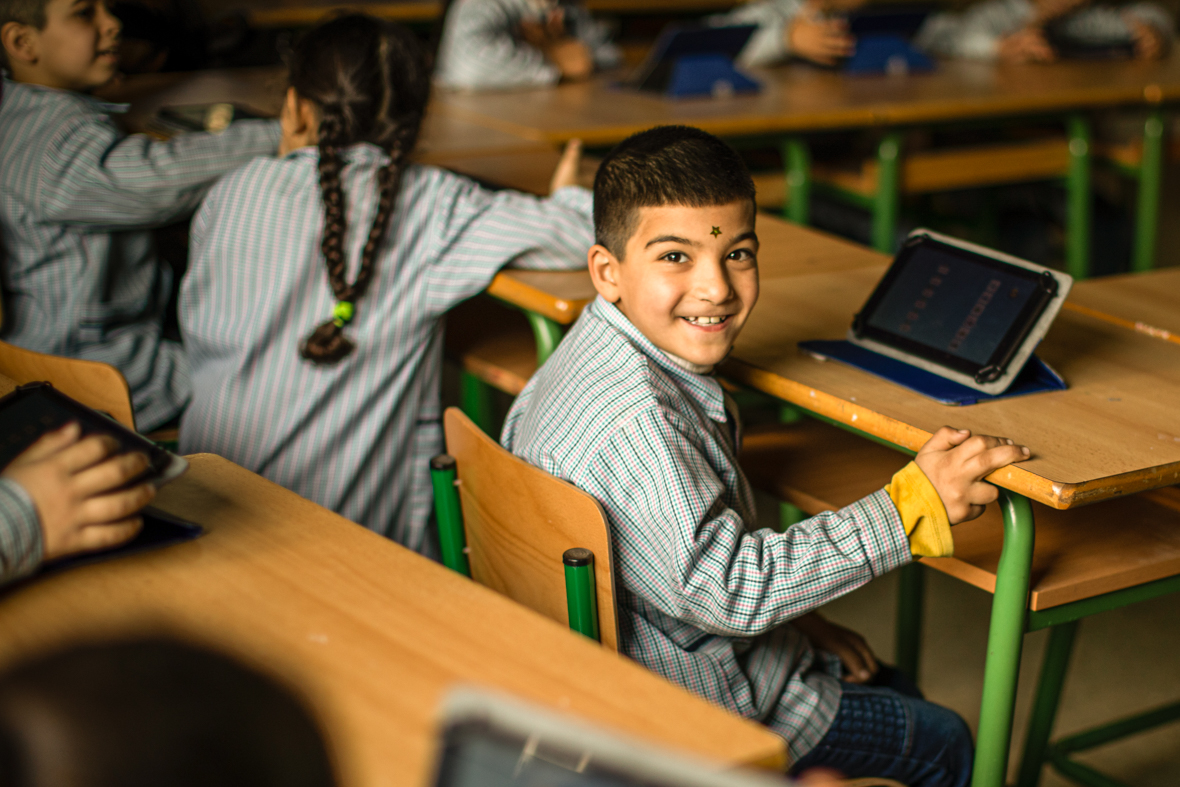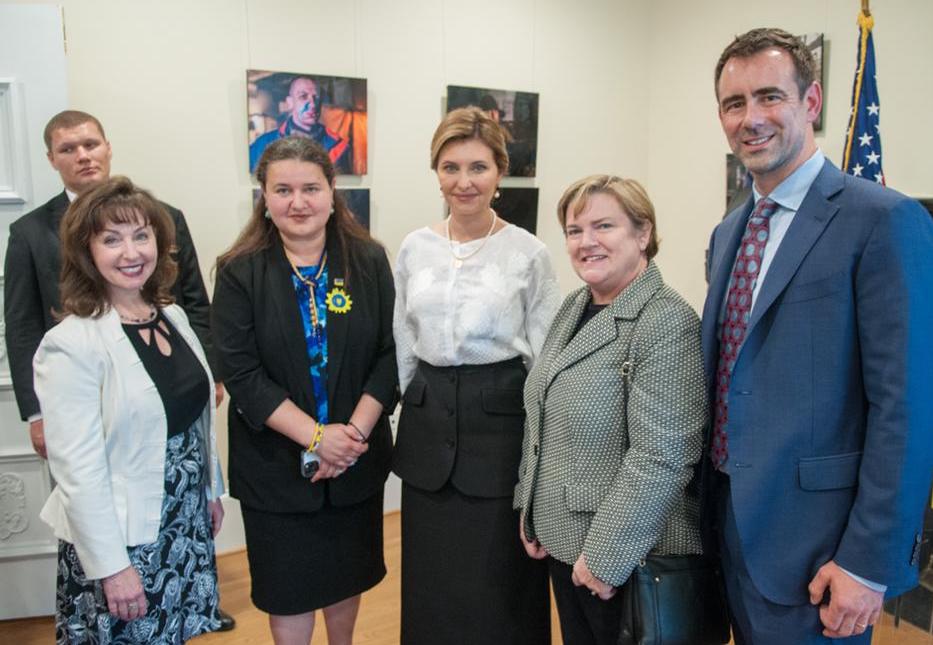
What you need to know about the Education in Emergencies Global Consultation
Children in conflicts, Education funding, Education in emergencies
Gordon Brown talks to Syrian children at a class in Lebanon
Gordon Brown called it “the year of fear” for children. 2015 was when the global community sat up and took notice of the urgent need for children living through conflicts and natural disasters to be in school and learning.
Now the United Nations Special Envoy for Global Education and other champions are determined to make 2016 the year when bold and lasting action is taken on education in emergencies.
At the heart of that process is the Education in Emergencies Global Consultation – when opinions and ideas will be gathered from all over the world on a new platform to generate commitment and funding for millions of children whose schooling is affected by crises.
A World at School, our network of Global Youth Ambassadors and our sister organisation the Global Business Coalition for Education are all playing key roles in this process by giving their views.
The consultation – led by INEE, the international network for education in emergencies – began yesterday and will run until February 5.
Allison Anderson, INEE consultant facilitating the global consultation process, said: “Thus far, the majority of the decisions about a ‘common platform’ for education in emergencies and protracted crises have been made by high-level policymakers.
“Given the immense aim of this common platform – to generate political commitment and financial resources for meeting the educational needs of millions of children and young people affected by crisis – it is critical that those with actual experience receiving education and working on education in countries affected by crises weigh in on the options proposed in the consultation process.
“They need to do that in order to shape the decisions around what and how such a common platform should – and shouldn’t – do.”
Here’s our guide to the consultation and how you or your organisation can take part.
Bhabindra Thami reads his book in a temporary makeshift tent in Kathmandu after the Nepal earthquake Picture UNICEF/Panday
What is meant by an emergency?
Conflicts or wars, natural disasters and health-related crises, such as the Ebola outbreak.
How many children live in emergency settings?
An estimated 65 million children aged three to 15 are directly affected by emergencies and protracted crises, according to the Overseas Development Institute. About 37 million children – 22 million of primary age and 15 million of lower secondary age – are out of school in crisis-affected countries.
The Syrian conflict has put 2.7 million children out of school in the region. In Nigeria, 1.4 million children have been displaced by Boko Haram violence.
In Nepal, the earthquake destroyed more than 90% of the schools in the hardest-hit regions. In West Africa, five million children were forced out of school for months by the Ebola crisis – and many will never return.
Are boys and girls affected equally?
The ODI estimates girls are 2.5 times more likely to be out of school than boys in conflict situations.
What does being out of school mean for these children?
Providing education is critical. If children are out of school entire generations could be lost to child labour, child marriage, recruitment into fighting or other life-threatening activities. Educating children contributes towards peacebuilding and rebuilding damaged communities.
Children from conflict-torn Central African Republic at a refugee camp in Cameroon Picture: OCHA/Ivo Brandau
With each year of education that a child misses, the human, social and economic costs rise. Their families and communities remain in poverty.
The average time a refugee spends away from their home is 17 years. Refugees who have missed out on educational opportunities also lack the skills to return to their homes and help rebuild services such as education, health and government.
How much would it cost to get these children into school?
An estimated extra $4.8 billion per year – $74 per child on average – would be enough to ensure children affected by crises get an education.
So why is that money not being spent on education in emergencies?
There is a misconception that education is not immediately critical to save lives. That means it is the first service to be sacrificed and the last to be rebuilt in emergencies.
Despite the biggest refugee crisis since World War II, there has been a drop in funding for education in the poorest and most volatile settings. In 2014 only 1% of humanitarian relief was invested in education and creating safe places for children to recover and rebuild their futures.
Who is trying to change that?
More education campaigners have been pushing for action. But Gordon Brown put the global spotlight firmly on the issue during a speech one year ago at the World Economic Forum in Switzerland.
He said: “We need an emergency fund for education when there are humanitarian crises. We should not have to wait more than a year for help to come when we have a plan and could act immediately. A child needs hope and education and a future.”
According to INEE, that “prompted a renewed conversation among developing and donor countries, UN agencies and non-government organisations about how best to solve these challenges”.
Displaced children in Gaza are read a story at a school where they sheltered during attacks in 2014 Picture: UNICEF/d’Aki
What happened next?
In July a joint call to action, led by A World at School and signed by more than 40 leading NGOs and campaign organisations in the run-up to the Oslo Summit on Education for Development, called for “new and immediate finance to deliver education alongside protection and other essential social services”.
At the summit an agreement, backed by strong political will, was reached on the need to create a common platform to improve how aid is provided in emergencies.
That decision was informed by Education in Emergencies and Protracted Crises: Toward a strengthened response – a paper produced by the ODI in advance of the summit. This paper was consulted on during Phase I of the Education in Emergencies Global Consultation.
What happens during Phase II?
INEE says: “Energised by this commitment, global partners have mobilised to diagnose and address finance, coordination and capacity gaps that hinder the provision of education in crisis contexts.”
These partners are now working together to develop solutions to be discussed and agreed ahead of the World Humanitarian Summit in May.
ODI has been commissioned by UNICEF on behalf of Gordon Brown, the Global Partnership for Education, key donors, affected governments and other stakeholders to set out options that will address gaps and complement existing structures and processes.
What is the timeline for the process?
The consultation – or public discussion of the ODI paper – runs from January 19 to February 5. It includes discussion forums, an online questionnaire, webinars and personal consultations.
After this, ODI will incorporate all the input from the consultation and write a final paper. In March, the Technical Strategy Group created at the Oslo Summit will review the paper and make recommendations to key stakeholders.
The new platform and solutions will then be launched at May’s World Humanitarian Summit.
How can I take part in the consultation?
You can participate in online discussion forums, an online feedback survey and webinars in five languages.
There will also be in-person consultations as part of INEE’s Meet-Up event, as well as country-specific consultations conducted by the ODI team in a number of crisis-affected countries.
More news

